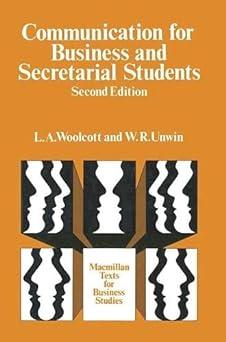1. Read the following passage and answer the questions below: The Flexible Time-Clock Flexible working hours is...
Question:
1. Read the following passage and answer the questions below:
The Flexible Time-Clock Flexible working hours is a system which, by putting an end to the nine to five working day myth, brings a more human touch to the working situation, but forces nobody into another straitjacket. It does not demand, either, that the individual, who is set in his ways, should change his habits. With flexible working hours, the working day is split into three sections- one when everyone must be present (the core time)
and two at either end of the day (the flexible bands when everyone can come and go as he pleases). Flexible working hours started in Germany and was developed by the personnel manager of Messerschmitt·BolkowBlohm GmbH, a large company in Munich in the aerospace industry.
The staff problems with which he was faced were the same as in any large conurbation. The commuting problem, however, is different, since the offices, a large modern block with about 4,000 employees, are on the outskirts of Munich and are not well served by public transport.
The system was introduced in 1968, and quickly spread not only in his company but throughout Germany and to othe parts of the Continent.
It is now estimated that there are well over 2,000 applications of the system. It has been adopted in administrative organisations, insurance companies, and head offices, as well as in local and central government.
One of the latest and most interesting applications is in a retail clothing store - although, given the varying traffic volumes and reliance on parttime assistants, it is surprising that the idea was not born in the retail environment.
In the system core times are set to coincide with the daily peak demands on the organisation- in an office from 10 a.m. until 4 p.m.and flexible bands are added during which employees can be present or not at their will. In the office situation, these might well be between 8 a.m. and 10 a.m .. and 4 p.m. and 6.3 0 p.m. The main restrictions, apart from presence during the core time, is that over a given settlement period, which can be a week or a fortnight, but more usually a month, employees have to work the total number of hours for which they have contracted, i.e .. if the contracted time is seven hours per day, they have to be present in total for 140 hours in a month of 20 working days.
There are refinements. Many companies have added an additional flexible band to cover the lunch break. Employees can not take up to 1 Y2 hours, but they must observe a minimum of half-an-hour. Most companies which have implemented this system allow a further conces·
sion; the possibility of a debit or credit carry forward of up to ten hours. Debit/credit hours should be made up, or taken, during the flexible bands of the following settlement period; but some companies allow a half day per month off in core time against accumulated credit hours.
It is not all 'blue skies' however. But nor has the old adage that if you give a man enough rope he will hang himself proved true, either.
At Messerschmidt-Bolkow-Blohm, for example, employees are almost always in credit to the tune of, on average, approximately four hours per employee. There are other advantages to the company, according to a survey carried out by the German Personnel Management Association Out of a total or thirty companies replying, improvement in working atmosphere was reported by 24; reduction of paid absence by 25;
reduction of overtime worked by 15; increased productivity by individuals adjusting hours worked to their own best work rhythm by 17;
improved recruitment success by 19; and reduced personnel turnover by 6.
(Management Today, January 1973)
(a) Summarise in not more than 100 words how the flexible work-hours system works.
(b) Give the meaning of the following expressions, as they are used in the passage:
straitjacket conurbation commuting settlement period 'blue skies'
(c) What advantages does the system have (i) for employers, (ii) for employees?
(d) What disadvantages can you forsee?
Step by Step Answer:

Communication For Business And Secretarial Students
ISBN: 9780333148679
2nd Edition
Authors: Lysbeth A Woolcott






